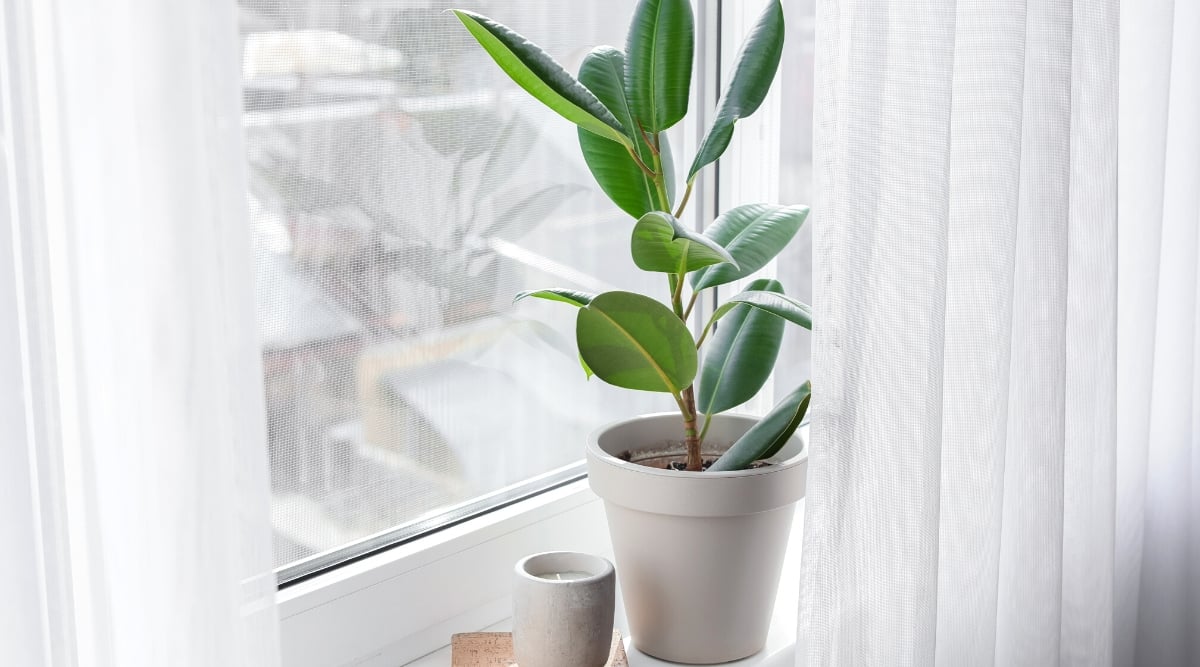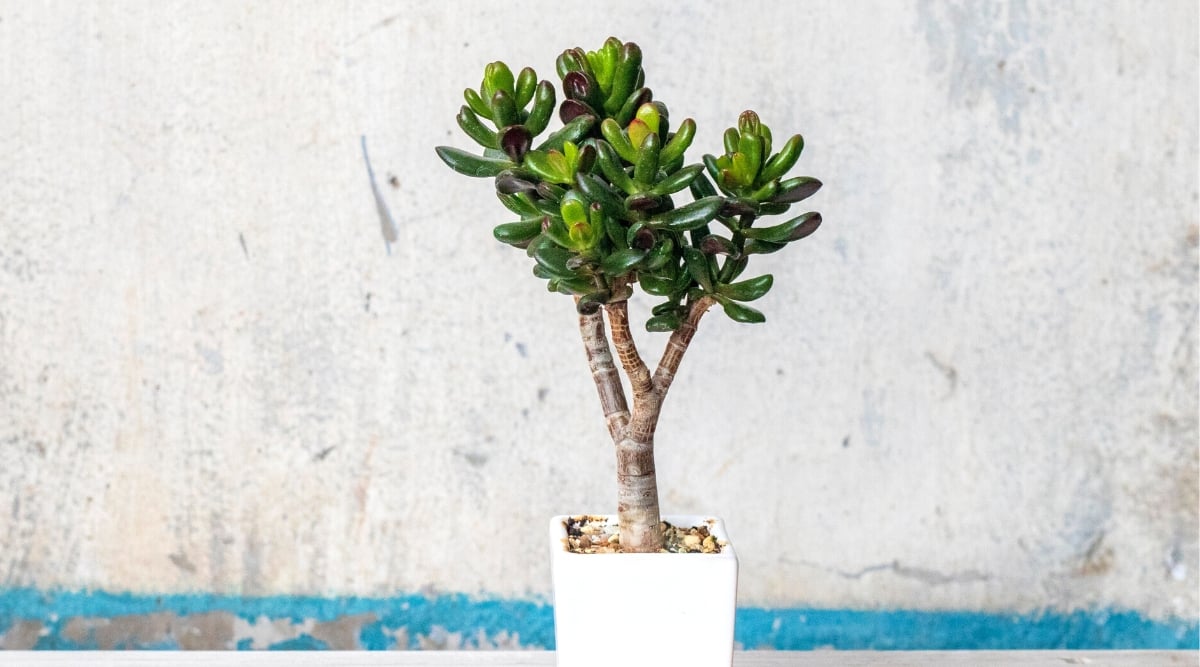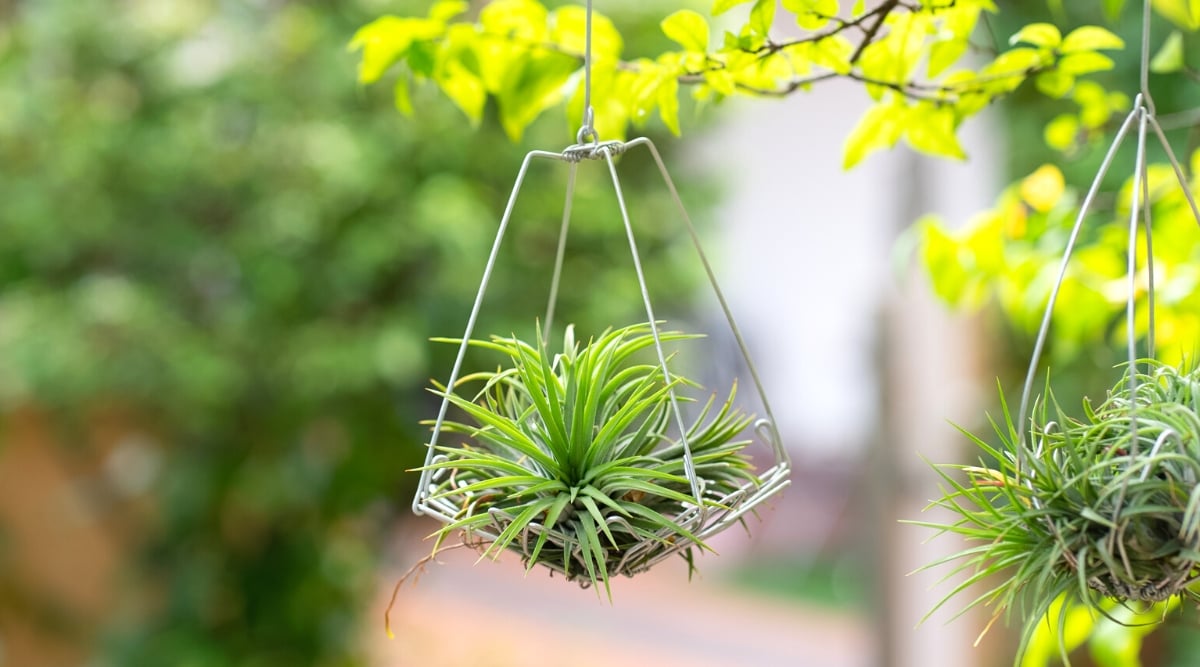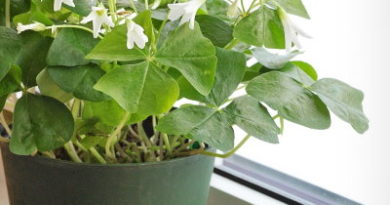19 Houseplants Perfect For College Dorm Rooms
Finding houseplants for a college dorm room is no simple task. You must contend with small spaces, lack of light, and easy access to care, all while considering how much time you’ll have to care for your plants throughout the year.
Despite the challenges, houseplants are worth it. I made my first-ever solo garden purchase when I was in college. I felt the lack of greenery negatively impacted my mood and overall well-being. Plants not only make a space look better, but they make you feel better too. If you’re struggling to focus, indoor plants boost productivity.
If you’re searching for the perfect plant for your college dorm room, this list covers a range of options for different conditions. But be careful… once you buy one, you’ll probably want them all!
Snake Plant

Snake plants are famous for many things, from sharp and variegated leaves to comical common names like mother-in-law’s tongue. They survive almost anywhere and under anyone’s care, so much so that they’re impossible to kill.
You can place a snake plant almost anywhere, and it will quickly adapt to its new environment. They prefer mostly bright indirect light with a few hours of morning sun, but they can even survive low-light areas for relatively long periods. The leaves will likely stretch a bit, and the plant may not grow as well as expected, but they won’t die within a week or two like some fussier houseplants.
Cast Iron Plant

The common name for Aspidistra elatior says all you need to know about difficulty in care. This species is famous for its indestructible nature, requiring minimal care to thrive for years and years. As evidence of this easygoing nature, we’ve had a cast iron plant in our family for almost 20 years, with no major special attention other than watering every two weeks or so.
In stark contrast to the structural shape of snake plants, cast iron plants have large soft leaves that look somewhat similar to peace lilies. They also grow quite large in the right pot, adding a lot of greenery to your dorm room.
Spider Plant

No need to worry about the common name of this plant – they aren’t related to spiders (and don’t attract them). Chlorophytum comosum earns its name because of the resemblance of the tiny plantlets cascading over the leaves to tiny spiders. Luckily, they are completely harmless (even to your pets).
Spider plants are ideal for dorm rooms with only a little wall or shelf space because they make great hanging plants. If you have space to hang just one plant in your dorm, the spider plant is your answer. The cascading leaves look full and lush in baskets, and in the proper lighting, you may even spot a few of their adorable flowers.
ZZ Plant

Another entry on the indestructible houseplant list is the ZZ plant. Shortened from its botanical name, Zamioculcas zamiifolia, some call it the Zanzibar gem after its African native origins. This plant has rows and rows of small leaves packed onto long arching stems. Not only is it easy to care for, but it is one of the most unique-looking houseplants you can find.
ZZ plants grow relatively slowly. So, if you’re short on space in your dorm room, look for a younger plant that won’t outgrow its pot too quickly.
Although they grow best in bright indirect light, sometimes even tolerating a bit of direct sun in the cooler parts of the day, they can survive well in low-light areas. They also need very little watering, thanks to their thick rhizomes. In other words, don’t worry if you forget a watering session or two.
Pothos

Famous for its ease of care, pothos is one of the most popular houseplants worldwide. The trailing vines cascade down the sides of the containers, making them ideal for baskets or shelving to add a ton of greenery to a gloomy dorm room with little space. These plants survive low light conditions better than most and tolerate less watering, too, preferring neglect over excessive care.
As an added bonus, there are also many different pothos cultivars to choose from, each with interesting colors and variegation patterns. ‘Golden’ pothos is the classic option, with shiny flecks of yellow, but if you prefer more muted tones, you can try ‘Marble Queen.’
Both the ‘Jade’ pothos and ‘Neon’ pothos lack the variegation, with solid deep green or lime green leaves, respectively. Choose the perfect option to fit your college dorm room plan, or gather a few for an easy-care houseplant collection.
Heartleaf Philodendron

This philodendron species causes confusion because it looks so similar to the pothos. They come from completely different genera and have slightly different growth habits, but they also share many characteristics that make this plant perfect for any college dorm room.
The trailing or climbing vines of the heartleaf philodendron grow incredibly quickly. In the right light levels and with a touch of fertilizer, you can grow an entire living wall with heartleaf philodendron vines and a trellis. Use this lush wall to divide your space or simply inject some much-needed nature into your room.
Heartleaf philodendrons are not needy plants and are able to grow in low light and with little attention. They need water more often than pothos plants to prevent the leaves from wilting but are otherwise carefree.
Peace Lily

Peace lilies are common gifting plants around the world. In fact, they’re a popular gift for college-bound students who need to decorate their dorm rooms! Luckily, they are perfectly suited for growing there.
Peace lilies are the ultimate houseplant, tolerating low light and thriving in containers. They prefer more water than some other houseplants, but if you water regularly, you shouldn’t have any trouble.
The other caveat to keeping a peace lily in your college dorm room is that it probably won’t flower in low-light areas. They need a full day of bright indirect sunlight to produce their stark white modified leaves and spadix flowers. However, the glossy and cascading foliage looks great on its own too.
Chinese Evergreen

For foliage lovers, you won’t need anything more in your dorm room than Chinese evergreen plants. There are many varieties of Aglaonema with unique colors and leaf patterns.
These full plants packed with leaves are remarkably easy to grow and thrive with little attention. Part of the Araceae plant family, they are closely related to several common tropical houseplants, including the peace lily.
Although ease of care is one of the main reasons people choose to grow these plants, there is also incredible variety in color and pattern between species. Some have different shades of green in a mottled pattern, while others feature a stripe of silver. And if you love color, there are also options with splashes of red, pink, or orange to choose from.
Dracaena

Dracaena is a genus of hardy trees and shrubs that grow to impressive heights outdoors in their native habitats. But, thanks to their love of tropical conditions, they are often planted in large pots and kept indoors as houseplants.
Most Dracaena species have an interesting structural look with pointed leaves, much like the snake plant. In fact, the snake plant has recently been reclassified under the Dracaena genus, explaining this connection.
As shrubs or trees with much thicker stems than herbaceous plants, dracaenas store more water than usual, able to survive long periods without a top-up. If you’re too focused on college work to remember to water your plants, this is the perfect option for you.
Rubber Plant

You may have heard of one of the most beloved houseplants of the recent houseplant boom – the fiddle leaf fig. Unfortunately, they also have a reputation for being tricky to care for. That’s where the rubber plant comes in.
This tree is also a member of the Ficus genus, like the fiddle leaf fig, scientifically known as Ficus elastica. However, it is much easier to care for than the fussy fiddle leaf and more tolerant of different environments.
It also features tall branches and large leaves to fill any empty corners in your room, but it is much less likely to drop those leaves than other ficus varieties.
Although regular rubber plants are stunning with their glossy green leaves, this species truly shines in the variegated versions. Look for margins of bright white variegation or dramatic red/pink cultivars for a pop of color.
Jade Plant

If you prefer the look and feel of succulent plants over leafy tropical plants, Crassula ovata is an ideal option for college dorm rooms. This structured beauty can be kept compact in a smaller container or allowed to grow larger than life when given the space to expand. They can even be shaped into bonsai trees for a unique look without the high maintenance.
Succulent plants are typically not great options for most college dorm rooms because of their high light demands. Luckily, jade plants are happy to live in much lower light than usual, displaying few signs of struggle. A spot with moderate to bright indirect light is enough for these plants to grow, albeit slower than usual.
The main benefit of growing jade plants is their waterwise nature. The thick juicy leaves and large stems store enough water to help them survive periods of drought. In fact, they are far more likely to be damaged by overwatering than underwatering.
String of Pearls

Another excellent option for hanging baskets is string of pearls. Part of the popular string succulents group, string of pearls is the original favorite that sparked interest from collectors.
The delicate vines feature adorable spherical leaves packed with moisture, adding to their waterwise capabilities. They are also happy to live in lower-light areas.
However, they prefer brighter spots with a bit of direct morning sun to aid in growth and moisture evaporation, preventing root rot. If you have a sunny windowsill in your dorm room or need a companion on your desk, you couldn’t ask for a better study buddy.
Because they are so delicate, keeping these plants out of high-traffic spots is important. The vines can break off easily if they are manhandled too often.
English Ivy

Also known as common ivy, the look of Hedera helix vines is instantly recognizable. They are most well-known for their invasive nature, smothering any plants in their path and spreading incredibly quickly. The leaves are also toxic to pets and humans, irritating the skin if touched.
But, if you’re keeping your English ivy contained in a pot in your dorm room and out of reach, it will likely become one of your favorite possessions. They add a wonderful ethereal look to interiors that pair well with soft furnishings and wood furniture.
Thanks to their rapid growth and ability to survive almost anywhere, they also thrive on neglect, meaning you can forget about them for a few days with few side effects.
Areca Palm

If your dorm room style is a ‘tropical resort’ rather than an ‘English cottage,’ look for one or two areca palms to fill your space. These classic houseplants are the first palm gardeners reach for, not only for their stunning arching fronds that grow remarkably tall for the small pots they are grown in but also for their ease of care.
Looking at an areca palm, you would assume it needs plenty of attention to grow well. Although strong in stature, the leaves do look delicate. But luckily, the opposite is true.
Areca palms are relatively easygoing when given the right amount of light. Ensure you keep them away from harsh direct sun to avoid scorching the leaves, and they should look as good as the day you bought them for months.
Air Plant

A more out-of-the-box dorm room option that can tolerate a wide range of conditions and needs minimal care is the air plant. Or, more specifically, air plants, as this is the common name given to a large group of epiphytes typically from the Tillandsia genus.
Rather than growing in soil, these interesting species are attached to pieces of wood (or other natural materials) to root, absorbing moisture from the air. The pointed leaves of these plants are unique and look great when mounted on walls or hung in front of a sunny window out of the path of direct sun.
You may even spot flowers with the right care, although they need near-perfect conditions to produce blooms. Simply dunk them in a bucket of water around once a week or mist them frequently, and you’ll have no trouble keeping your air plants happy.
Chinese Money Plant

Pilea peperomioides is a compact plant that packs a big punch. Known for its fascinating round leaves and overall spherical shape, it is also called the pancake plant or UFO plant. But most often, you’ll see it named Chinese money plant for the leaves’ resemblance to coins.
If you don’t have much space in your college dorm room, Chinese money plants are great space-savers that grow well in small pots. When purchased young, they won’t grow tall very quickly, making them an ideal desk topper. They are also easy to fit into any room design, with a structural yet softened look thanks to the rounded leaves.
As long as you don’t forget to water these plants, you won’t experience many problems growing them. In the right conditions, they will also develop small plantlets around the base that you can use to propagate.
Wax Plant

Members of the Hoya genus are known as wax plants for their waxy leaves and blooms in a range of interesting shapes and colors. There are several species to choose from, with different growth habits and looks, but all are considered easy to grow.
My first Hoya survived for years after several moves, kept going even with many missed waterings, and lived through an intense mealybug infestation. If they can survive that, they can definitely survive a college dorm room.
If you don’t have the right light, you probably won’t see your wax plant flower. But you can still enjoy the waxy foliage, often featuring interesting patterns and colors. They don’t need water very often and can easily survive in moderate to bright indirect light.
Money Tree

This year, one trending houseplant is taking over from previous favorites like fiddle leaf fig and monstera. That plant is Pachira aquatica, commonly known as the money tree.
This interesting species often comes with braided stems underneath narrow, glossy leaves, which look instantly recognizable. They don’t take up much space in their small containers but still look larger than life.
Money trees are named so because of the belief that the plant brings its owners financial prosperity (certainly a benefit for college-goers). However, if that doesn’t work for you, you can still enjoy this plant’s unique look and ease of care.
String of Hearts

Another member of the popular string succulents group, string of hearts, is one of the most unique of all. This plant features adorable heart-shaped leaves with mottled patterns, making them incredibly popular around Valentine’s Day.
The vines also develop interesting tubers that can be used to grow even more plants – ideal for quickly filling your college dorm room with greenery without a high cost. You have several options when choosing how best to display your string of hearts.
The vines look great when cascading down the sides of containers, either on the edge of a shelf or from a hanging basket. Or, if you’re feeling adventurous, you can train the vines up any wire structure (mine is shaped like a heart) to keep the growth more compact.
Final Thoughts
Houseplants add a fun and homey accent to college dorm rooms. Whether you’re packing up for your new place or gifting a college-bound family member, these low-maintenance plants are a perfect addition to the dorm necessity checklist!




